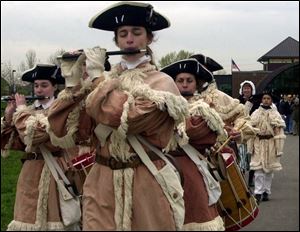
Reinvention of Ohio Historical Society tied to its future
7/4/2004
Volunteers in period costumes march into Fort Meigs during the May, 2003, rededication of the renovated War of 1812 fort.
COLUMBUS - The 119-year-old Ohio Historical Society says it's becoming more "entrepreneurial."
In the short term, "entrepreneurial" means fewer employees, higher admission fees, reduced off-season hours, and not as many tours at some sites.
Significant cuts in state aid and declining attendance have forced the private, not-for-profit keeper of 60 Ohio historic sites and innumerable artifacts to realize it can no longer rely on taxpayers for 70 percent of its operating funds.
"It means thinking more like a private sector business, thinking of our visitors as customers and how to maximize the satisfaction that they have while they're here so they come back again," said Bill Laidlaw, the society's executive director.
Between 1996 and 2000, when Ohio was giving back hundreds of millions a year in excess revenue to taxpayers, money for the historical society's operating expenses jumped nearly 23 percent to $13.9 million.
After the bubble burst, state aid plummeted 14.3 percent by the time the state entered its bicentennial year in 2003. Ohio Village in Columbus, a living-history re-creation of a 19th-century village on society grounds, was closed and remains so except for special events.
State aid climbed briefly in fiscal year 2004, covering the last half of the bicentennial celebration, but resumed its decline with the fiscal year that began Thursday. The Columbus-based organization says it knows that when lawmakers have to choose between funding Medicaid or schools and funding history, history loses.
"This is something whose time has come," said Dr. Richard Ruppert, the former president of the Medical College of Ohio who joined the historical society's board a year ago.
"If it was just a matter of saying we're going to do this to get through the bad years and then go back to the old model, I don't want to be a part of it," he said.
This year lawmakers forced the historical society to present a new game plan before the Ohio Controlling Board would consider releasing its funding.
"As I left the legislature, I did not see any effort to change. They felt things were fine the way they were," said Kerry Metzger, a former Republican state representative and current Tuscarawas County commissioner. He led a 2001-02 legislative task force whose recommendations served as the backbone for many changes now being tackled by the society.
"With the new executive director, there's a new environment," he said. "It's going to take time, but I'm seeing a willingness to try new things that wasn't there in the past. They will bottom out, and then the changes they are beginning to make will do some good as they start back up the plateau again."
Mr. Laidlaw, a former academic administrator at Case Western Reserve University's management school, was hired at an annual salary of $165,000 by the society's board of trustees last year as the board sought someone with a business and nonprofit background rather than history.
The society's plan includes aggressively going after private foundation money, charging more at turnstiles, beefing up book and souvenir sales, marketing itineraries for tourists involving multiple attractions, and examining whether to turn some sites over to local control.
"If the money was coming easily from the state and there wasn't any pressure, you wouldn't be forced to go out and look," said Mr. Laidlaw. "Now we've got to get creative and find new ways to do it, and we're out there competing with everybody else. I think we'll be a stronger organization because of it."
Although he feels the changes are inevitable, Andrew Cayton, history professor and author at Miami University of Ohio, fears the days relished by ardent historians like him may be vanishing.
"We live in a Disney culture," he said. "In order to make these kinds of places attractive, you have to spend a lot of money to upgrade them for consumers. You need first-class facilities.
"Just looking at a mound or a president's gravesite is not going to cut it," he said. "You need a gift shop, food, parking facilities. You need to make a positive, persuasive case that there are good, tangible, concrete reasons why we need these things, that it would make us less a people or a state if we didn't have them."
The society points to Fort Meigs in Perrysburg as an example of where it wants to go. The 1813 fort built to repel the British has undergone a resurrection after major improvements with borrowed state capital funds, including the addition of meeting rooms available for public rental.
The Campaign for Fort Meigs, led by Dr. Ruppert, has also raised nearly $1 million in local support toward a $1.5 million goal. The money will be used to make more permanent enhancements to the fort and to create a permanent endowment.
"You can never do things as well from a distance of 140 miles between Columbus and Toledo," said Dr. Ruppert. "We're doing a whole series of things to become more entrepreneurial, to convince sites to work to support themselves. Groups are holding meetings there [at Fort Meigs]. People are buying books and artifacts, and the profits come back to the fort."
He suggested the society must also look at whether the 60 sites it oversees, the most managed by any state in the country, are too many. Similar talks must take place focusing on the innumerable artifacts and papers the society has accepted responsibility for and are now little more than warehoused in Columbus.
The society is asking for $12 million in borrowed capital funds from the state to build a new collections storage center.
Contact Jim Provance at: jprovance@theblade.com or 614-221-0496.